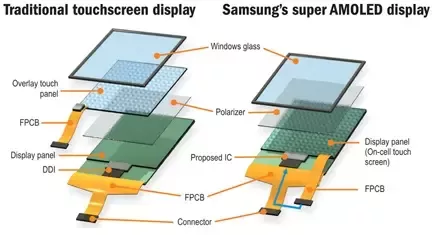Protect Your Eyes with sAMOLED Displays: The Next Step in Eye-Friendly Technology
In recent years, the smartphone industry has been rapidly changing and upgrading various features of phones to provide a better user experience. Display technology has become one of the essential aspects of smartphones. One such technology is sAMOLED. This article is written for people who want to learn about sAMOLED Display in the easiest way possible.

What is sAMOLED Display?
sAMOLED, short for super Active Matrix Organic Light-Emitting Diode or Super-AMOLED Display, is a combination of two display technologies, AMOLED and Super AMOLED. It is an advanced version of the standard AMOLED display that uses an additional touch-sensitive layer on top of the display. The layer is made up of highly conductive material and provides faster response times, better touch sensitivity, and deeper blacks.

What is the benefit of sAMOLED Display?
sAMOLED displays offer several advantages over traditional Mobile Display:
- Rich and Vibrant Colors: Super-AMOLED displays produce deeper blacks and more vivid colors due to their ability to individually control each pixel. This results in a more realistic and immersive viewing experience.
- High Contrast Ratio: With a much higher contrast ratio compared to LCD displays, sAMOLED screens deliver sharper and more detailed images. The difference between the brightest and darkest colors is significantly greater, enhancing overall visual quality.
- Improved Viewing Angles: Super AMOLED displays provide wider viewing angles, ensuring clear visibility from various perspectives. This feature is particularly beneficial for group viewing or when the screen is viewed from unconventional angles.
- Thinner and Lighter Design: Because they do not require a separate backlight, Super-AMOLED displays can be made thinner and lighter than LCD displays. This makes them well-suited for slim and lightweight devices like smartphones and tablets.
- Enhanced Battery Life: Super AMOLED displays are more energy-efficient, especially when displaying darker content. This efficiency can contribute to improved battery life, allowing users to enjoy longer usage times between charges.
Difference Between Super-AMOLED Display and AMOLED Display:
The main difference between sAMOLED and AMOLED displays is the extra touch-sensitive layer on top of the display. The touch layer allows for more responsive touch interaction, which is essential in today’s fast-paced, touchscreen-oriented world.
| Feature | sAMOLED Display | AMOLED Display |
|---|---|---|
| Full Name | Super AMOLED Display | Active-Matrix Organic Light-Emitting Diode Display |
| Technology | Builds upon AMOLED | Base technology |
| Touch Sensor Integration | Integrated touch sensor layer | May require separate touch sensor layer |
| Brightness | Generally brighter | Can vary depending on implementation |
| Power Consumption | Lower power consumption, especially in dark conditions | Lower power consumption compared to LCD |
| Cost | More expensive | Less expensive |
| Manufacturer | Primarily used by Samsung | Used by various manufacturers |
Is sAMOLED Display better than AMOLED?
Yes, Super AMOLED displays are better than AMOLED displays in a few ways. Super-AMOLED displays offer better touch sensitivity, faster response times, and deeper blacks, making the display quality superior. It also provides a more power-efficient experience, which is essential in a smartphone where the battery is crucial.
Is sAMOLED Display good for eyes?
Yes, sAMOLED displays are good for eyes, in fact, they are better than traditional LCD displays. The key difference between sAMOLED and LCD displays is that while LCD displays use a backlight to produce light, Super-AMOLED displays produce their light from each individual pixel. As a result, sAMOLED displays produce less visible flicker, which can help reduce eye strain.
Which is best sAMOLED Display or LCD?
Both sAMOLED and LCD displays have their own advantages and disadvantages. sAMOLED displays are generally superior in terms of the display’s quality, while LCD displays are generally better in terms of power efficiency. This is because Super AMOLED displays use more power on high-brightness settings compared to LCD displays. It depends on the user’s requirements, which one to choose.
Best sAMOLED Display Phones in India:
There are plenty of smartphones available in India with Super AMOLED displays. Here are some of the top-rated models:
1) Samsung Galaxy S21 Ultra
2) OnePlus 9 Pro
3) Vivo X60 Pro
4) Samsung Galaxy Note20 Ultra 5G
5) Oppo Find X3 Pro
6) Samsung Galaxy F15 5G
Conclusion:
sAMOLED displays are an advanced version of the standard AMOLED display that provides better touch sensitivity and faster response times. sAMOLED displays have become a popular choice among smartphone manufacturers due to their excellent image quality, high contrast levels, and brighter whites. Super AMOLED displays are better than traditional LCD displays, particularly in terms of reducing eye strain. In conclusion, Super-AMOLED displays are a desirable choice for smartphone users who prioritize display quality over other aspects.




